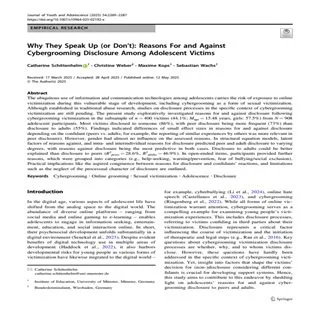By Catherine Schittenhelm , . Christine Weber , Maxime Kops , Sebastian Wachs
The ubiquitous use of information and communication technologies among adolescents carries the risk of exposure to online victimization during this vulnerable stage of development, including cybergrooming as a form of sexual victimization. Although established in traditional abuse research, studies on disclosure processes in the specific context of cybergrooming victimization are still pending. The present study exploratively investigated reasons for and against disclosure following cybergrooming victimization in the subsample of n = 400 victims (44.1%; Mage = 15.48 years, girls: 57.5%) from N = 908 adolescent participants. Most victims disclosed to someone (86%), with peer disclosure being more frequent (73%) than disclosure to adults (55%). Findings indicated differences of small effect sizes in reasons for and against disclosure depending on the confidant (peers vs. adults; for example, the reporting of similar experiences by others was more relevant in peer disclosure). However, gender had almost no influence on the assessed reasons. In structural equation models, latent factors of reasons against, and intra- and interindividual reasons for disclosure predicted peer and adult disclosure to varying degrees, with reasons against disclosure being the most predictive in both cases. Disclosure to adults could be better explained than disclosure to peers (R2 peers = 28.6%, R2 adults = 46.9%). In open-ended items, participants provided further reasons, which were grouped into categories (e.g., help-seeking, warning/prevention, fear of bullying/social exclusion). Practical implications like the aspired congruence between reasons for disclosure and confidants’ reactions, and limitations such as the neglect of the processual character of disclosure are outlined.
Youth Adolescence (2025).





